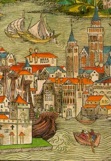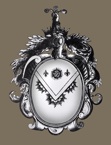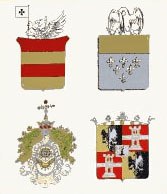Iacomo Ragazzoni
Ragazzoni Family originates from Valtorta (Bergamo). In 1457 Milan ceded Valtorta to Venice. During that period, the most advanced and distinguished members of the family emigrated. Some of them settled in Brescia, others went to Venice, to Mortara, to Milan or as far as to Canton Ticino. To differ the new descendants of the various stocks a second surname was given them. Since that moment we have: Ragazzoni Uberti, Alberti, Carlotti and Prevedoni. The Ragazzoni Alberti settled in Venice. In the year 1525 Benedetto Ragazzoni married Isabetta Izzo. The couple had a good number of children, among them Iacomo who was born in 1528. Iacomo was an extremely talented child and, though very young, his parents sent him to London at the Henry VIII Royal Court. The Court appreciated him so much that Maria Tudor awarded him the privilege of adding to the coat of arms of the Ragazzoni Alberti family the “Rose of Tudor”.
In London Iacomo was known under the name of James Ragoson (from the National Archives).
Se vuoi saperne di più clicca qui
Iacomo, from London back to Venice
Once in Venice, Iacomo devoted himself to his family business. He developed his activities mainly in two directions: commercial activity and public life.
In 1561 he married Piccabella and they gave birth to 16 children.
Se vuoi saperne di più clicca qui
Cyprus and the tragic events leading to the Battle of Lepanto
The Ottomans decided to quicken the conquest of Cyprus: after a first successful assault to the island without meeting any resistance, they proceeded to the capital city of Nicosia and then to Famagosta. Battles had been extremely fierce.
Se vuoi saperne di più clicca qui
Iacomo in Constantinople and the possessions in Cyprus
Venetian Senate sent Iacomo to Constantinople to deal with the Turks a separate peace with the purpose of defending Venetian interests as well as the possessions in the island of Cyprus.
Se vuoi saperne di più clicca qui
Iacomo back to Venice
Back to Venice Iacomo reported important information about arms and supplies used by the Turkish army. At the end of his public duties he involved himself in the reinforcement of his fortunes, adding to his previous possessions in Veneto 750 fields in Sacile territory. Here he decided to build, beside other things, a splendid palace. Such place became Iacomo’s favourite residence and its illustrious guests called it “the House of Delights”.
Se vuoi saperne di più clicca qui
The Battle of Lepanto
The clash between the Ottomans and the Holy League took place at Lepanto on the 7th of October 1591.
Se vuoi saperne di più sulla battaglia di Lepanto clicca qui
Royal Visitors
In 1574 Iacomo Ragazzoni gave hospitality in Sacile to the King of France, Henry III of Valois from whom he received the Insignia of Honour. In 1581 Ragazzoni Family gave hospitality in their palace to the Empress Maria of Austria, daughter of Charles V.
Se vuoi saperne di più sull'evento clicca qui
Honorary Titles
Iacomo and Placido Ragazzoni received from the Doge Alvise Mocenigo the ring and the title of Count of San Odorico, Venice 1573. Placido Ragazzoni received from the King of France Henry III the Order of Knightwood, France 1583.
Se vuoi saperne di più sugli eventi clicca qui
Iacomo’s death and the fall of the family
After a number of painful losses, unlucky events and a distressing illness, the life of Iacomo came to an end on the 18th of January 1610.
His beloved nephew, Giacometto, succeeded him but a series of errors caused the murder of the young Earl during a gunfight.
















